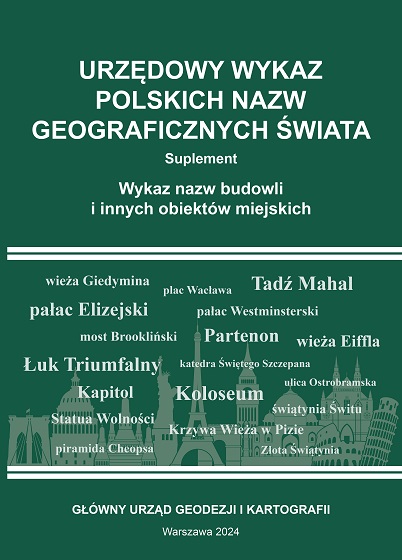„Official list of polish geographical names of the world. Supplement: List of names of buildings and other urban objects”
The second edition of the “Official List of Polish Geographical Names of the World”, prepared by the Commission on Standardization of Geographical Names Outside the Republic of Poland operating at the Surveyor General of Poland, was published in 2019. This publication contains the Polish names of geographical objects located outside Poland, i.e. Polish exonyms, recommended by the Commission. It contains Polish names for 13,599 geographical objects. However, it does not include the names of buildings and structures, such as temples, monasteries and other places of worship, forts, fortresses, castles, bridges, stations, airports or names of streets, squares, cemeteries, necropolises and city parks (these names may be considered urbanonyms). The “List of names of buildings and other urban objects” is a supplement to the “Official List of Polish Geographical Names of the World” containing systematized names of objects of that type.
The list refers to features where the use of Polish names is recommended, such as wieża Eiffla [Eiffel Tower], Koloseum [Colosseum], piramida Cheopsa [Cheops Pyramid], świątynia Szmaragdowego Buddy [Temple of the Emerald Buddha], Biały Dom [White House]. In the case of some objects, publications contain completely Polonized names or their original name, possibly with a translated generic term only. In such cases, the exonym is included in the list only if the Polish name is more often used. If the original name is more popular, (e.g. katedra Notre-Dame [Notre-Dame Cathedral] rather than katedra Najświętszej Marii Panny [St. Mary’s Cathedral] in Paris, Ponte Vecchio rather than most Złotników [Goldsmiths Bridge] or Stary Most [Old Bridge] in Florence), such an object is excluded from the list as the Commission does not recommend an exonym for it. A number of popular names where only the generic term is Polonized are also omitted, e.g. pałac Buckingham [Buckingham Palace], pałac Sanssouci [Schloss Sanssouci] – the translation of the generic term into Polish may, if necessary, be done ad hoc.
The publication takes into account the Commission’s resolutions adopted by 12 June 2024. The list contains names of 1691 objects from 133 countries and territories. The basic criterion for selecting objects was their popularity and cultural significance. For obvious reasons, this popularity and significance are considered from a Polish perspective, hence the dominance of objects from the European area, and within Europe, a large representation of objects from areas formerly belonging to Poland.
Two kinds of names are included in the list of geographical features: Polish geographical names (exonyms) and the corresponding original names (endonyms, i.e. names in the language spoken where the given feature is located). It should be stressed that the Commission on Standardization of Geographical Names Outside the Republic of Poland is responsible for standardization of the Polish names only, excluding any standardization of original names, especially since, unlike geographical objects, buildings and structures often do not have a formally established name, and common or colloquial names are used for them, sometimes even the administrators of a given building use different names or different forms of its name in official documents.
The list is divided into six parts (chapters) with names of objects from particular parts of the world (i.e. Europe, Asia, Africa, North America, South America, Australia and Oceania). Within the chapters, names are listed according to alphabetical order of countries and non-self-governing territories. Names of objects from the areas of individual countries and non-self-governing territories are arranged by 16 categories. The entries related to particular geographic features present a Polonized form in front of it. This is followed by the genitive and locative form of the name or information that the name is undeclinable, and an adjective if it is derived from a given name. In the next part of the entry, the original name (endonym) in the official language is given – or the original names, if more than one official language applies. For non-Roman writing systems, the original form of the name is given and its romanized form (i.e. converted to the Roman script) in accordance with the romanization rules recommended by the Commission. For most of these languages, both Polish transcription and transliteration are provided. The exceptions are several Asian languages, for which it is recommended to use only international romanization. It is worth emphasizing that the Polish transcription does not mean that we are dealing with a Polish name – despite being written in Polish letters, the name remains an endonym. The names are followed by the geographical coordinates of the feature, usually accurate to one arc second. For linear features (especially streets), the coordinates of both ends are given.
In some cases, Polish variant names or Polish equivalents of official names (especially for church names) are given. In such instances, the name that comes first is the one that the Commission considers most appropriate, however, the others are also acceptable. In square brackets, additional information and notes can be found, e.g. the town in which the object is located, additional characteristics of the object or its location, selected historical names of the object. At the end of the publication, there is an index of all Polish names included in the list, including historical names.
See also
https://www.gov.pl/web/ksng-en/list-of-polish-geographical-names-of-the-world
